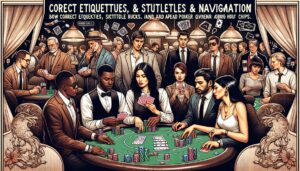In the realm of poker, where fortunes can be made or lost with a single card, the ability to conceal one’s intentions and feelings becomes as crucial as the strategy employed in play. The term “poker face” has transcended the tables, becoming synonymous with the art of deception in popular culture. But within the context of poker, it represents a fundamental skill that separates the novices from the masters. This article delves into the essence of crafting the perfect poker face, exploring the psychological underpinnings and practical techniques that enable players to maintain composure and control.
The Psychological Foundation
At its core, the poker face is a manifestation of emotional regulation and nonverbal communication. It’s about creating a visage that is unreadable to opponents, masking the excitement of a strong hand or the disappointment of a weak one. This skill hinges on the player’s ability to detach themselves from the immediate emotional responses triggered by the game’s ups and downs.
Emotional Intelligence: High emotional intelligence is a trait shared by successful poker players. It allows them to not only manage their emotions but also to read and interpret the emotions of others. Developing emotional intelligence involves self-awareness, self-regulation, and the empathy to understand the emotional states of opponents
Strategies for Developing a Poker Face
- Physical Control: The first step in mastering the poker face is gaining control over your physical reactions. This includes facial expressions, body movements, and even the timing of your breathing. Techniques such as deep breathing and relaxation exercises can help in maintaining a calm demeanor.
- Consistency in Behavior: A key aspect of a successful poker face is consistency. Your actions, behaviors, and betting patterns should not betray the strength of your hand. This means adopting similar routines and mannerisms regardless of the situation, making it difficult for opponents to discern any tells.
The Art of Deception
Deception in poker goes beyond maintaining a neutral expression; it’s about actively misleading your opponents. This includes bluffing, slow playing, or even displaying false tells to manipulate the perceptions of other players. The art of deception is a strategic layer on top of the foundational poker face, requiring not just emotional .
- Bluffing: Bluffing is the most recognized form of deception, where a player bets aggressively on a weak hand to convince opponents of its strength. Effective bluffing relies on the credibility of the bluff, often built on the player’s image and betting history.
- False Tells: Intentionally displaying misleading cues, or false tells, can be an advanced tactic to throw off observant opponents.
Conclusion
Mastering the poker face and the art of deception is a journey of self-discovery, requiring patience, practice, and psychological insight. Beyond the mechanics of the game, poker is a study in human nature, and the poker face is the player’s canvas.
Baca Juga : Stacking Chips, Building Fortunes: A Guide to Profiting in Casino Poker


